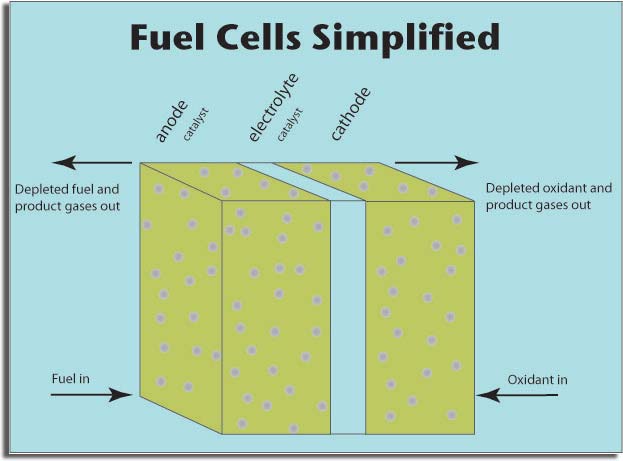In
its purest form, a fuel cell is like a battery. The difference is
that it never runs dry as long as you keep supplying it with fuel
and air. As opposed to today’s widespread power generation
techniques, fuel cells contain no moving parts to wear out and produce
a miniscule amount of by-products. Instead of burning fossil fuel
compounds and creating literally tons of waste in the form of air
pollution, this new technology provides a venue where molecules
are exchanged in a chemical process that creates electricity.
Best
case scenario: Off the grid
The most practical near-term applications of fuel cell technology
is off-the-grid power generation at office buildings and small communities
via an on-site fuel cell stack. Once the semi-portable device is
cost-effectively manufactured, they can be extended to third world
countries that lack infrastructure to support traditional, industrial-era
power grid. This low impact power generation has dramatic potential
here.
The second tangible benefit is the
lack of by products, i.e. pollution. Burning coal creates literally
tons of sulphur dioxide and nitrogen oxide that is released into
the environment. However by converting hydrogen-based petrochemicals
to electricity is a very clean, efficient process. Because the process
involves a chemical reaction, the only waste product is what goes
in.
The best fuel found in relative abundance
right now is methane gas or CH4. As you can tell from the equation,
there are four hydrogen atoms available and two carbon atoms that
will be left over as a by-product. This carbon by-product then can
be put to use by adding to a garden or using it to filter water.
Other candidates include natural
gas, however the disadvantage being the addition of other elements
such as sulphur into the system, which produces poisonous sulphur
gas as a by-product. Overall, the more hydrogen molecules in relation
to other elements in the fuel, mean a cleaner “burning”
fuel. (Although no combustion takes place.)
Standardization of fuel is currently
an important goal of the scientific community as the dwindling supplies
of fossil fuel are becoming more evident. A standard fuel will then
lead to standardization of gas tanks and refueling infrastructures—all
required to implement hydrogen fuel cell technology on a larger
scale.
Ending the geopolitical struggle
The benefits of clean efficient fuel reach far beyond your winter
heating bill. Right now, China and other developing third world
countries are in the process of industrialization. As we saw in
this country over the past century, industrialization by means of
fossil fuel causes tremendous havoc on the environment. We’re
only just beginning to see those effects now. The fossil fuel supply
fall far short of the demand brought on by these countries and the
environmental consequences could be drastic. Now that supplies are
diminishing, global conflict is on the rise as each country scrambles
to secure as much energy as possible.
Another major benefit of fuel cell
technology would be to curb this global conflict. Just imagine if
the United States didn’t care about what was under Iraq. Suffice
it to say that if the U.S. was not dependent on the oil in the middle
east, there would not be 100,000 + troops over there in harm’s
way. Tomorrow’s terrorists wouldn’t have as much opportunity
for target practice.
Chemistry
creating energy
A fuel cell consists of an anode and a cathode separated by a electrolyte,
much like a battery consists of two different metals separated by
a conductive liquid. On the anode side of the equation, there is
an abundance of hydrogen atoms that consist of the system’s
fuel, typically supplied as a petrochemical gas. On the cathode
side, oxygen is supplied together with a catalyst. The two different
elements, hydrogen (H) and oxygen (O) naturally want to be together
to create water, H2O. This tendency creates a potential across the
electrolyte, which is measured electrically speaking, by voltage.
A voltage potential is kind of like
an apple and gravity. Holding the apple four feet off the ground
will create four feet of potential. This tendency to move with gravity
is analogous to what happens in the middle of a fuel cell across
the electrolyte. Think of it kind of like a single’s bar where
men and women go to succumb to their magnetism for each other and
come together. But just the presence of men and women don’t
guarantee interaction, you need alcohol—the catalyst! In the
fuel cell world, this catalyst is simply an electrical load applied
to the circuit. In other words, you need to add a little energy
to start creating energy.
When oxygen is applied to the cathode,
the catalyst helps by breaking the oxygen bonds down by giving each
atom a negative one charge. These unbalanced atoms then, move through
from the cathode chamber to the electrolyte, through a three-phase
boundary. Once the oxygen atom reaches the electrolyte, it moves
across the space between the cathode and anode, looking for a positive
charge to balance its negative charge. The very specific porosity
of the electrolyte controls the flow, otherwise the system would
short out.
When the oxygen atom bonds with
protons and electrons on the other side, water is created (H2O)
along with electricity and heat. And this is what we use as power!

Right now there are many different
types of fuels being researched, but the best fuel sources are hydro-carbon
gasses such as methane and natural gas. The purest and most efficient
gasses are compounds that contain little or no other elements besides
hydrogen and carbon, that can hinder the chemical process or create
unruly by products.
Currently the main obstacles to
implementation on a grand scale are materials engineering, cost
per kilowatt and standardization of technology.
We're on our way!
Its amazing what humankind can create in a time of need. The world
is growing faster than fossil fuels can support. Not only are we
looking at the inevitable end of fossil fuel production to supply
our needs, the environment is starting to show signs of wear and
tear. Luckily fuel cell technology has been around since the advent
of the steam engine and the scientists of the world have decided
its time to figure this out.
Once scientists break through the
current obstacles, people all around the world will reap the benefits
of hydrogen fuel cell technology. Imagine, instead of war and global
warming, we can live off the grid and grow organic vegetables with
our electricity exhaust!
Jon
Heinrich |

